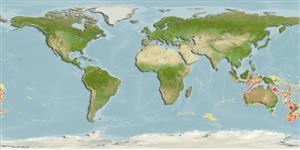Holocephali (chimaeras) >
Chimaeriformes (Chimaeras) >
Chimaeridae (Shortnose chimaeras or ratfishes)
Etymology: Chimaera: Named for the mythological creature composed of parts of multiple animals, referring to their odd mix of characteristics. (See ETYFish); macrospina: macro-, from makros (L.), long; spina (L.), thorn or spine, referring to long dorsal spine, taller than dorsal fin. (See ETYFish).
More on authors: Didier, Last & White.
Environment: milieu / climate zone / depth range / distribution range
Ecology
Marine; bathydemersal; depth range 435 - 1190 m (Ref. 76965). Temperate
Indo-West Pacific area of Australia.
Size / Weight / Age
Maturity: Lm ? range ? - ? cm
Max length : 93.9 cm TL male/unsexed; (Ref. 76965); 103.4 cm TL (female)
Short description
Morphology | Morphometrics
This species is distinguished from its congeners by the following characters: skin thin and deciduous; color uniformly chocolate brown; preopercular and oral lateral line canals usually sharing a common branch; long dorsal spine, longer than first dorsal fin; adult male with short claspers (11-13% BDL), trifurcate, divided at about distal third of clasper; structure of the CO1 gene (Ref. 76965).
Life cycle and mating behavior
Maturity | Reproduction | Spawning | Eggs | Fecundity | Larvae
Didier, D.A., P.R. Last and W.T. White, 2008. Three new species of the genus Chimaera Linnaeus (Chimaeriformes: Chimaeridae) from Australia. In Last, P.R., White, W.T. & Pogonoski, J.J. (eds.): Descriptions of New Australian Chondrichthyans. CSIRO Marine and Atmospheric Research Paper no. 22. (Ref. 76965)
IUCN Red List Status (Ref. 130435)
Threat to humans
Harmless
Human uses
More information
Common namesSynonymsMetabolismPredatorsEcotoxicologyReproductionMaturitySpawningSpawning aggregationFecundityEggsEgg development
Age/SizeGrowthLength-weightLength-lengthLength-frequenciesMorphometricsMorphologyLarvaeLarval dynamicsRecruitmentAbundanceBRUVS
ReferencesAquacultureAquaculture profileStrainsGeneticsElectrophoresesHeritabilityDiseasesProcessingNutrientsMass conversion
Tools
Special reports
Download XML
Internet sources
Estimates based on models
Phylogenetic diversity index (Ref.
82804): PD
50 = 0.5000 [Uniqueness, from 0.5 = low to 2.0 = high].
Bayesian length-weight: a=0.00282 (0.00118 - 0.00673), b=3.10 (2.89 - 3.31), in cm total length, based on LWR estimates for this (Sub)family-body shape (Ref.
93245).
Trophic level (Ref.
69278): 3.7 ±0.6 se; based on size and trophs of closest relatives
Resilience (Ref.
120179): Low, minimum population doubling time 4.5 - 14 years (Preliminary K or Fecundity.).
Fishing Vulnerability (Ref.
59153): High vulnerability (62 of 100).
